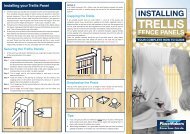what we learned from christchurch taking the risk out ... - PlaceMakers
what we learned from christchurch taking the risk out ... - PlaceMakers
what we learned from christchurch taking the risk out ... - PlaceMakers
Create successful ePaper yourself
Turn your PDF publications into a flip-book with our unique Google optimized e-Paper software.
FEATURESBRANZEarthquake performanceBRANZ research shows that houses built to <strong>the</strong> current Building Code and standards generally stood up<strong>we</strong>ll to <strong>the</strong> Canterbury earthquakes. Ho<strong>we</strong>ver, more complex, specifically designed houses often had issuesThe earthquakes that have struckCanterbury since 4 September2010 have provided anopportunity for engineers to compare<strong>the</strong> actual performance of a widerange of structures against <strong>the</strong>oreticalexpectations.This has been particularly true forBRANZ structural engineers, whohave been closely involved <strong>from</strong> <strong>the</strong>initial event, first in <strong>the</strong> emergencyresponses to <strong>the</strong> main earthquakes of4 September 2010, 22 February 2011and 13 June 2011, and <strong>the</strong>n in <strong>the</strong>recovery operations centred on <strong>the</strong>region’s housing stock.HOUSE AND GROUNDPERFORMANCEFollowing <strong>the</strong> June 2011 earthquake,BRANZ conducted a comprehensiverandom survey of over 300 housesin Christchurch to gain a betterappreciation of <strong>the</strong> performance of<strong>the</strong> range of house types, including<strong>the</strong> effects of ground conditions.Houses on <strong>the</strong> flat had ei<strong>the</strong>r beenaffected by ground failure resulting<strong>from</strong> <strong>the</strong> earthquakes (liquefaction)or by earthquake shaking. Whilepredominantly affected by shaking,some hillside houses <strong>we</strong>re also affectedby ground instability such as rock fall,rock roll, and slope and cliff failure.To varying degrees, liquefactionaffected a large proportion of houseson <strong>the</strong> flat. Of <strong>the</strong> properties surveyedon <strong>the</strong> flat, 30% experienced liquefactionof <strong>the</strong> site, with half of <strong>the</strong>se havingliquefaction in all three major earthquakeevents before <strong>the</strong> survey.CHRISTCHURCH FOUNDATION STYLESThe survey sample confirmed <strong>the</strong>re havebeen two predominant foundation stylesin Christchurch over <strong>the</strong> history of <strong>the</strong>city. Houses built in <strong>the</strong> early and middle20th century generally have floors onpiles with perimeter concrete foundationwalls, while most houses built since 1980have concrete slab-on-ground foundations.When <strong>the</strong> ground liquefied, nei<strong>the</strong>rfoundation style was sufficiently robust,leaving many houses uninhabitable.Many of <strong>the</strong> perimeter concrete foundationwalls supported heavy brick or blockcladdings and heavy concrete or clay tileroofs. When <strong>the</strong> liquefaction was severe,<strong>the</strong>se walls settled into <strong>the</strong> ground at agreater rate than <strong>the</strong> more lightly loadedpiles, resulting in a badly distorted house.The slab-on-ground floors <strong>we</strong>re also hithard by <strong>the</strong> soil liquefaction. Many of<strong>the</strong> slabs <strong>we</strong>re unreinforced (acceptablein NZS 3604 construction before <strong>the</strong>earthquakes), and those that <strong>we</strong>re hadbrittle reinforcing mesh fractured as <strong>the</strong>slab distorted. The <strong>the</strong>n DBH issued anamendment to its citation of NZS 3604,requiring all new floors in New Zealandbe reinforced with ductile reinforcing.NEED FOR STRONGER FOUNDATIONSThe Engineering Advisory Group(EAG) has developed a range ofmore robust foundation systems fornew houses on properties where<strong>the</strong>re is a likelihood of liquefaction infuture earthquakes. Some foundationsare expected to accommodate <strong>the</strong>associated ground distortions withminimal distortion of <strong>the</strong> house –stiff rafts – while o<strong>the</strong>rs have beendesigned so re-levelling is a relativelyeasy process – suspended timber floors.O<strong>the</strong>r solutions involve treating <strong>the</strong>ground before <strong>the</strong> house is built tocontain <strong>the</strong> liquefying soils and providea stiff soil platform for <strong>the</strong> foundation.Repairs would still be required in manyinstances, but <strong>the</strong>se would be minor and<strong>the</strong> disruption to occupants is expectedto be low.Now, Christchurch probably has <strong>the</strong>best database of subsoil informationof any territorial authority (TA) in <strong>the</strong>country, allowing a more informedselection of appropriate foundationsystem for <strong>the</strong> conditions.O<strong>the</strong>r TAs with known areas ofliquefiable soils, particularly where <strong>the</strong>reis also potentially high seismicity, shouldconsider <strong>what</strong> house foundations orground treatments are most appropriateto ensure resilient performance.14www.branz.co.nzThis house was effectively destroyed because of damage to foundations resulting <strong>from</strong> liquefaction
















